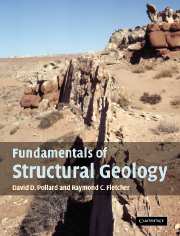Chapter 8 - Elastic deformation
Summary
Comparison of displacement field components near an edge dislocation from phase images of experiments (left column) and from anisotropic elastic theory (right column). (a) and (b) displacement component ux parallel to bottom edge of image. (c) and (d) displacement component uy parallel to left edge of image. Photograph reproduced from (Hytch et al., 2003) with kind permission of Martin J. Hytch.
The conceptual success of the [infinitesimal theory of elasticity and the linear theory of viscosity] is perhaps the broadest we know in science: in terms of them we face, “explain”, and in varying amount control, our daily environment: winds and tides, earthquakes and sounds, structures and mechanisms, sailing and flying, heat and light (Truesdell and Noll, 1965).
In this chapter we describe how the elastic properties of rock are measured in the laboratory and provide tables of numbers representing the range of values for different rock types. However, the need to understand and measure the resistance to deformation of rocks goes well beyond the simple accumulation of numbers in handbooks of rock properties. To paraphrase Truesdell and Noll (1965), the aim of structural geology is to construct mathematical models that enable us, from use of knowledge gathered in a few observations, to predict by logical processes the outcomes in many other circumstances. To analyze a geologic structure one must choose the appropriate boundary or initial value problem to serve as a mechanical model. To formulate such a problem one must postulate a particular mechanical behavior.
Information
- Type
- Chapter
- Information
- Fundamentals of Structural Geology , pp. 287 - 332Publisher: Cambridge University PressPrint publication year: 2005
